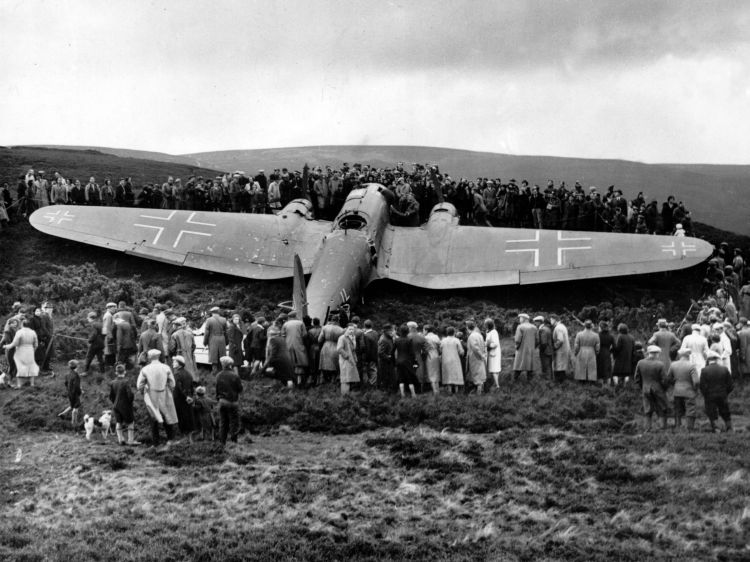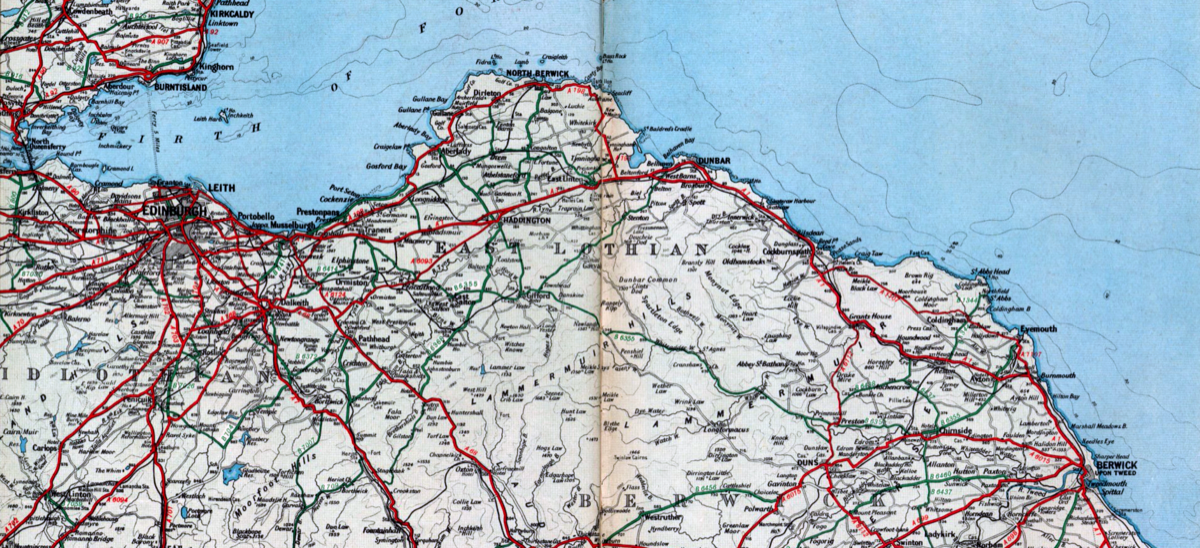Introduction
In the Twenty First century East Lothian remains predominantly a rural county just as it was in 1939. Most of its inhabitants worked in farming, its associated trades, down one of its many coal mines situated to the west of the county or as fishermen sailing from a port like Dunbar or Port Seton. Life here was spent largely though not exclusively at the pace of the horse or tractor and, compared to many other British counties, its war was to be a fairly quiet one.
However, still waters run deep. Lying as it does just east of Scotland’s capital, Edinburgh, and within distant sight of the great naval base of Rosyth and the towering ironwork of the Forth Rail Bridge, East Lothian was to have its moments.
By a strange quirk of fate East Lothian played host to some of its more dramatic experiences at the very beginning and the very end of the war. Aerial bombing of the UK mainland was to commence over its skies and the first German aircraft to be shot down on the mainland fell on Kidlaw, not far from the small village of Humbie.

In 1945 three JU 52s, painted white for ease of identification, ferried German staff officers to Drem to sign the surrender of all German military forces in Norway. That these forces had remained in Norway in the first place was a tribute to the success of Operation Fortitude North, the northern part of the allied deception plan preparatory to the D-Day landings and largely carried out from the Lothians.
In between these significant events lay a county experiencing a world war: its inhabitants undergoing all the worries, irritants and excitements of a people playing their part in the depths of this cruel contest between life and death. To fight or train alongside them came men and women from all over the world. The graveyards of East Lothian play sad host to men and women from countries as far apart as Poland, New Zealand, South Africa and Canada. East Lothian had its war.
In between these significant events lay a county experiencing a world war: its inhabitants undergoing all the worries, irritants and excitements of a people playing their part in the depths of this cruel contest between life and death. To fight or train alongside them came men and women from all over the world. The graveyards of East Lothian play sad host to men and women from countries as far apart as Poland, New Zealand, South Africa and Canada. East Lothian had its war.

The rural county of East Lothian sits on the southern coastline of the Firth of Forth in eastern Scotland.
The aim of this website is to bring the actions and experiences of those who lived through the Second World War in East Lothian to wider notice.
This will be done through:–
This will be done through:–
- A History of Events
- Eyewitness Accounts
- Photographs
Please access the site menu by clicking on
the three black bars at the top right of this page.
The development of this site is an on-going process and will probably never be completed!. Please be patient and revisit to discover updates, which are listed below in the Progress Diary.
Progress Diary - latest entry: 4th April 2024
Apr. 2024 - Additional material on the B-17 crash, Drem in Air Accidents.
Sept. 2023 - SOE page: reminiscences about Eric Schwarz and Noe Czupper, SOE agents.
Aug. 2023 - Alice Hubber (née Engels) got in touch. Bottom of Whittingehame Farm School page.
July 2023 - Peter Heinz Pollok identified on the two Whittingehame Farm School pages.
July 2023 - New page on Anthony La Gruta in Air Accidents.
May 2023 - Additional information about the numbers killed at Ferny Ness in 1943.
April 2023 - Correction on Gosford PoW camp etchings page.
April 2023 - Additional information re Garvald Work Camp.
Nov. 2022 - New page on Gunner James Drysdale, Haddington.
July 2022 - Gosford PoW - Rolf Stahl photos. Working on Wheatrig Farm.
July 2022 - Small addition to Garvald PoW camp page.
Apr. 2022 - Significant additions and alterations to the Whittingehame Farm School page.
Apr. 2022 - Link to film of Polish female soldiers in Gullane inserted in Polish Army in East Lothian page.
Mar. 2022 - X-Craft model, Old Aberlady Inn.
Jan. 2022 - Garvald Work Camp uploaded to PoW camps pages.
Jan. 2022 - End of war media page: three photographs uploaded.
Jan. 2022 - Amisfield PoW camp page uploaded in Home Front.
Oct. 2020 - Website relaunched to modern standards of accessibility and security.
27 Feb. 2013 - 1st Website launched.
Sept. 2023 - SOE page: reminiscences about Eric Schwarz and Noe Czupper, SOE agents.
Aug. 2023 - Alice Hubber (née Engels) got in touch. Bottom of Whittingehame Farm School page.
July 2023 - Peter Heinz Pollok identified on the two Whittingehame Farm School pages.
July 2023 - New page on Anthony La Gruta in Air Accidents.
May 2023 - Additional information about the numbers killed at Ferny Ness in 1943.
April 2023 - Correction on Gosford PoW camp etchings page.
April 2023 - Additional information re Garvald Work Camp.
Nov. 2022 - New page on Gunner James Drysdale, Haddington.
July 2022 - Gosford PoW - Rolf Stahl photos. Working on Wheatrig Farm.
July 2022 - Small addition to Garvald PoW camp page.
Apr. 2022 - Significant additions and alterations to the Whittingehame Farm School page.
Apr. 2022 - Link to film of Polish female soldiers in Gullane inserted in Polish Army in East Lothian page.
Mar. 2022 - X-Craft model, Old Aberlady Inn.
Jan. 2022 - Garvald Work Camp uploaded to PoW camps pages.
Jan. 2022 - End of war media page: three photographs uploaded.
Jan. 2022 - Amisfield PoW camp page uploaded in Home Front.
Oct. 2020 - Website relaunched to modern standards of accessibility and security.
27 Feb. 2013 - 1st Website launched.
Help Us - please!
It is hoped that you, the reader, will make your own contribution to this website. I would be very grateful for additional evidence and for notification of any errors or omissions. Please send such observations or contributions to the contact email address below. I will always acknowledge a contribution on the site when the source of this contribution is known.
Sources
The core information on this site is based on research carried out by a group based in Haddington which was inspired and organised by the late Jack Tully Jackson. Jack's initial website was a copy of two books written by Ian Brown and published under joint authorship. These were, “East Lothian at War Volume 1” & “East Lothian at War Volume 2”. [Now out of print]
A second version of The East Lothian at War website added additional information and used iWeb software. This version was soon outdated by IT developments and has been closed.
You are now visiting the third version of eastlothianatwar.co.uk
Author And Thanks
Key to the second and third versions of the East Lothian at War website has been the knowledgeable guidance and assistance provided by Kevan Gordon of Fix my Mac, Tranent. The website wouldn't have got very far without his unselfish and generous help.
Of huge significance too, has been the financial assistance and support provided by Haddington History Society.
David Elder has provided many of the current photographs and the author of others has been indicated where known. My grateful thanks to them all.
The website is being maintained and expanded by David Haire, the site's custodian and author, who is adding additional information as his research allows.

